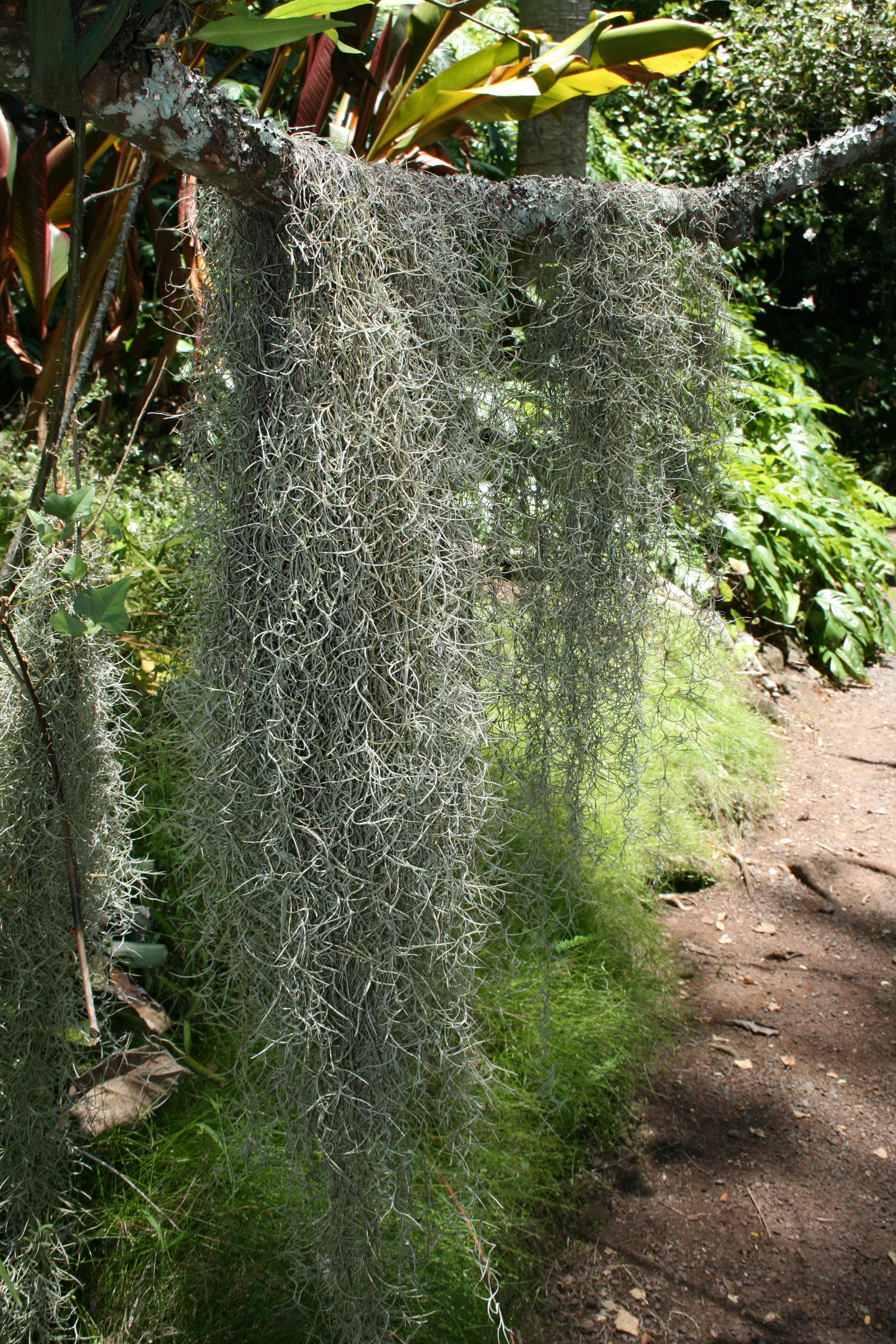- Spanish moss
image_width = 250px
regnum =Plant ae
divisio =Magnoliophyta
classis =Liliopsida
ordo =Bromeliales
familia =Bromeliaceae
genus = "Tillandsia "
species = "T. usneoides"
binomial = "Tillandsia usneoides"
binomial_authority = (L.) L.Spanish moss ("Tillandsia usneoides") closely resembles its namesake ("
Usnea ", or beard lichen). However, Spanish moss is not biologically related to eithermoss es orlichen s. Instead, it is aflowering plant in the familyBromeliaceae (the bromeliads) that grows hanging fromtree branches in full sun or partial shade. Formerly this plant has been placed in the genera "Anoplophytum", "Caraguata", and "Renealmia". [ [http://www.ars-grin.gov/cgi-bin/npgs/html/genus.pl?12153 Genus: Tillandsia L.] , GRIN Taxonomy for Plants, Agricultural Research Service, United States Department of Agriculture.] It ranges from thesoutheastern United States (southern Virginia and eastern Maryland) toArgentina , growing wherever theclimate is warm enough and has a relatively high averagehumidity .The plant consists of a slender stem bearing alternate thin, curved or curly, heavily scaled leaves 2–6 cm long and 1 mm broad, that grow vegetatively in chain-like fashion (pendant) to form hanging structures 1–2 m in length, occasionally more. The plant has aerial roots and its
flower s are tiny and inconspicuous. It propagates both by seed and vegetatively by fragments that blow on the wind and stick to tree limbs, or are carried bybird s as nesting material.Ecology
Spanish moss is an
epiphyte (a plant that lives upon other plants; from Greek "epi"=upon "phyte"=plant), which absorbsnutrient s (especiallycalcium ) andwater from the air andrain fall. Spanish moss is colloquially known as "air plant".It can grow so thickly on tree limbs that it gives a somewhat "gothic" appearance to the landscape, and while it rarely kills the trees it lowers their growth rate by reducing the amount of light to a tree's own leaves. It also increaseswind resistance , which can prove fatal to the host tree in ahurricane .In the southern U.S., the plant seems to show a preference of growth on southern live oak and bald cypress because of these trees' high rates of foliar mineral leaching (Ca, Mg, K, and P) providing an abundant supply of nutrients to the plant [William H. Schlesinger and P. L. Marks, [http://links.jstor.org/sici?sici=0002-9122%28197711%2F12%2964%3A10%3C1254%3AMCATNO%3E2.0.CO%3B2-U&size=LARGE&origin=JSTOR-enlargePage "Mineral Cycling and the Niche of Spanish Moss, Tillandsia usneoides L."] , "American Journal of Botany", Vol. 64, No. 10 (Nov.–Dec., 1977), pp. 1254–1262.] , but it can colonize in other tree species such as sweetgum, crape-myrtle, other oaks, or even pine.
Spanish moss shelters a number of creatures, including rat snakes and three species of bats. One species of spider, "
Pelegrina tillandsiae" (Salticidae ), has been found only on Spanish moss.Spanish moss in culture and folklore
Due to its propensity for growing in humid southern locales like Georgia,
Louisiana ,Mississippi ,Florida ,South Carolina , andAlabama , the plant is often associated withSouthern Gothic imagery.In the southeastern United States, the following tale is told:
:"As the story goes; there was once a traveler who came with his Spanish fiancée in the 1700s to start a plantation near the city of Charleston SC. She was a beautiful bride-to-be with long flowing raven hair. As the couple was walking over the plantation sight near the forest, and making plans for their future, they were suddenly attacked by a band of Cherokee who were not happy to share the land of their forefathers with strangers. As a final warning to stay away from the Cherokee nation, they cut off the long dark hair of the bride-to-be and threw it up in an old live oak tree. As the people came back day after day and week after week, they began to notice the hair had shriveled and turned grey and had begun spreading from tree to tree. Over the years the moss spread from South Carolina to Georgia and Florida. To this day, if one stands under a live oak tree, one will see the moss jump from tree to tree and defend itself with a large army of beetles." [ [http://soggybottomtours.com/Tales.html Tales ] ]
In Hawaiokinai, Spanish moss is occasionally called "Pele's hair" after Pele the Hawaiian goddess. The term "
Pele's hair " usually refers to a type of filamentousvolcanic glass .Legendary Canadian singer-songwriter
Gordon Lightfoot penned a ballad entitled "Spanish Moss". ["Saturday Night Live " transcripts, Season 1: Episode 21 (May 22 ,1976 ), [http://snltranscripts.jt.org/75/75umusic2.phtml Gordon Lightfoot performs "Spanish Moss"] .]Human uses
At one time, some 5,000 tons of Spanish moss were harvested and used in the U.S. alone.Fact|date=January 2008 The moss is sometimes bought for use in
arts and crafts , or for beddings for flowergarden s. The plant is commonly believed to be a habitat for chiggers, but only collects the mites after it has touched the ground. Spanish moss in its natural habitat, hanging from trees, does not harbor chiggers.Spanish moss is also known to have been worn by the women of the
Timucua Indian tribe."Tillandsia usneoides" as an entire plant has been used to treat
type II diabetes (mellitus),heart disease ,edema , andhemorrhoid s.Gallery
References
* [http://edis.ifas.ufl.edu/FR005 Spanish moss and ball moss]
* Mabberley, D.J. 1987. "The Plant Book. A Portable Dictionary of the Higher Plants". Cambridge University Press, Cambridge. ISBN 0-521-34060-8.
* [http://www.itis.gov/servlet/SingleRpt/SingleRpt?search_topic=TSN&search_value=42371 "Tillandsia usneoides" (Taxonomic Serial No.: 42371)] ,Integrated Taxonomic Information System
*Timucua#History External links
* [http://www.beaufortcountylibrary.org/rooms/documents/html/spanish.htm Spanish Moss: Its History, Nature and Uses -- Beaufort County Library]
* [http://www.sfrc.ufl.edu/4h/Spanish_moss/spanmoss.htm Florida Forest Plants]
Wikimedia Foundation. 2010.

